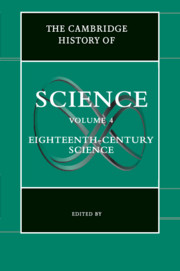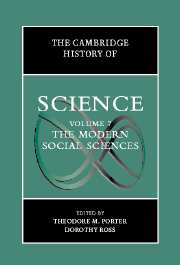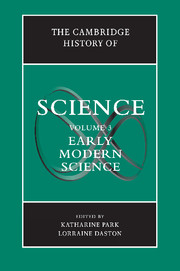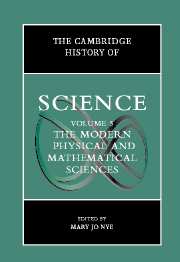Refine search
Actions for selected content:
10306 results in History of science: general interest
Bibliography of biographical sources
-
- Book:
- Evolution
- Published online:
- 16 October 2009
- Print publication:
- 24 April 2008, pp 279-283
-
- Chapter
- Export citation
Introduction
-
- Book:
- Evolution
- Published online:
- 16 October 2009
- Print publication:
- 24 April 2008, pp xiii-xviii
-
- Chapter
- Export citation
Cambridge
-
- Book:
- Origins
- Published online:
- 15 April 2010
- Print publication:
- 24 April 2008, pp 11-15
-
- Chapter
- Export citation
Contents
-
- Book:
- Evolution
- Published online:
- 16 October 2009
- Print publication:
- 24 April 2008, pp vii-viii
-
- Chapter
- Export citation
1867
-
- Book:
- Evolution
- Published online:
- 16 October 2009
- Print publication:
- 24 April 2008, pp 161-184
-
- Chapter
- Export citation
1857
-
- Book:
- Origins
- Published online:
- 15 April 2010
- Print publication:
- 24 April 2008, pp 177-199
-
- Chapter
- Export citation
1858
-
- Book:
- Origins
- Published online:
- 15 April 2010
- Print publication:
- 24 April 2008, pp 200-211
-
- Chapter
- Export citation

The Cambridge History of Science
-
- Published online:
- 28 March 2008
- Print publication:
- 17 March 2003

The Cambridge History of Science
-
- Published online:
- 28 March 2008
- Print publication:
- 04 August 2003

The Cambridge History of Science
-
- Published online:
- 28 March 2008
- Print publication:
- 03 July 2006

The Cambridge History of Science
-
- Published online:
- 28 March 2008
- Print publication:
- 28 October 2002
A witness account of solar microscope projections: collective acts integrating across personal and historical memory
-
- Journal:
- The British Journal for the History of Science / Volume 41 / Issue 3 / September 2008
- Published online by Cambridge University Press:
- 06 March 2008, pp. 369-383
- Print publication:
- September 2008
-
- Article
- Export citation
The return of Thomas Salusbury's Life of Galileo (1664)
-
- Journal:
- The British Journal for the History of Science / Volume 41 / Issue 2 / June 2008
- Published online by Cambridge University Press:
- 06 March 2008, pp. 241-265
- Print publication:
- June 2008
-
- Article
- Export citation
The enlightened microscope: re-enactment and analysis of projections with eighteenth-century solar microscopes
-
- Journal:
- The British Journal for the History of Science / Volume 41 / Issue 3 / September 2008
- Published online by Cambridge University Press:
- 06 March 2008, pp. 345-367
- Print publication:
- September 2008
-
- Article
- Export citation
From medicine to natural philosophy: Francis Hauksbee's way to the air-pump
-
- Journal:
- The British Journal for the History of Science / Volume 41 / Issue 2 / June 2008
- Published online by Cambridge University Press:
- 06 March 2008, pp. 209-240
- Print publication:
- June 2008
-
- Article
- Export citation
Stephen Clucas (ed.) John Dee: Interdisciplinary Studies in English Renaissance Thought. International Archives of the History of Ideas, 193. Dordrecht: Springer, 2006. Pp. xvii+366. ISBN: 1-4020-4245-0. €144.00, $189.00, £111.00 (hardback). ISBN: 1-4020-4246-9 (e-book).
-
- Journal:
- The British Journal for the History of Science / Volume 41 / Issue 1 / March 2008
- Published online by Cambridge University Press:
- 01 February 2008, pp. 132-134
- Print publication:
- March 2008
-
- Article
- Export citation
Sachiko Kusukawa and Ian Maclean (eds.) Transmitting Knowledge: Words, Images, and Instruments in Early Modern Europe. Oxford: Oxford University Press, 2006. Pp. xvi+274. ISBN 0-19-928878-X. £100.00 (hardback).
-
- Journal:
- The British Journal for the History of Science / Volume 41 / Issue 1 / March 2008
- Published online by Cambridge University Press:
- 01 February 2008, pp. 137-138
- Print publication:
- March 2008
-
- Article
- Export citation
Katharine Park and Lorraine Daston (eds.) The Cambridge History of Science, Volume 3: Early Modern Science. Cambridge: Cambridge University Press, 2006. Pp. xxvii+865. ISBN 0-521-57244-4. £90.00 (hardback).
-
- Journal:
- The British Journal for the History of Science / Volume 41 / Issue 1 / March 2008
- Published online by Cambridge University Press:
- 01 February 2008, pp. 136-137
- Print publication:
- March 2008
-
- Article
- Export citation
Books received
-
- Journal:
- The British Journal for the History of Science / Volume 41 / Issue 1 / March 2008
- Published online by Cambridge University Press:
- 01 February 2008, pp. 157-159
- Print publication:
- March 2008
-
- Article
- Export citation
Theodore Arabatzis, Representing Electrons: A Biographical Approach to Theoretical Entities. Chicago and London: The University of Chicago Press, 2006. Pp. xiv+295. ISBN 0-226-02420-2. $70.00, £44.50 (hardback). ISBN 0-226-02421-0. $28.00, £18.00 (paperback).
-
- Journal:
- The British Journal for the History of Science / Volume 41 / Issue 1 / March 2008
- Published online by Cambridge University Press:
- 01 February 2008, pp. 149-151
- Print publication:
- March 2008
-
- Article
- Export citation
